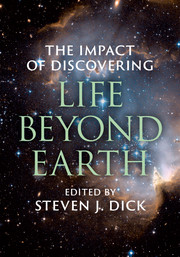Book contents
- Frontmatter
- Dedication
- Contents
- List of contributors
- Introduction: Astrobiology and society
- Part I Motivations and approaches: How do we frame the problems of discovery and impact?
- 1 Current approaches to finding life beyond Earth, and what happens if we do
- 2 The philosophy of astrobiology: The Copernican and Darwinian philosophical presuppositions
- 3 History, discovery, analogy: Three approaches to the impact of discovering life beyond Earth
- 4 A multidimensional impact model for the discovery of extraterrestrial life
- Part II Transcending anthropocentrism: How do we move beyond our own preconceptions of life, intelligence, and culture?
- Part III Philosophical, theological, and moral impact: How do we comprehend the cultural challenges raised by discovery?
- Part IV Practical considerations: how should society prepare for discovery – and non-discovery?
- Contributor biographies
- Index
- References
4 - A multidimensional impact model for the discovery of extraterrestrial life
from Part I - Motivations and approaches: How do we frame the problems of discovery and impact?
Published online by Cambridge University Press: 05 November 2015
- Frontmatter
- Dedication
- Contents
- List of contributors
- Introduction: Astrobiology and society
- Part I Motivations and approaches: How do we frame the problems of discovery and impact?
- 1 Current approaches to finding life beyond Earth, and what happens if we do
- 2 The philosophy of astrobiology: The Copernican and Darwinian philosophical presuppositions
- 3 History, discovery, analogy: Three approaches to the impact of discovering life beyond Earth
- 4 A multidimensional impact model for the discovery of extraterrestrial life
- Part II Transcending anthropocentrism: How do we move beyond our own preconceptions of life, intelligence, and culture?
- Part III Philosophical, theological, and moral impact: How do we comprehend the cultural challenges raised by discovery?
- Part IV Practical considerations: how should society prepare for discovery – and non-discovery?
- Contributor biographies
- Index
- References
Summary
Most science fiction books and movies depict extraterrestrials (ETs) that are similar to us in many ways. They are at our scale, have eyes, limbs, and body symmetries. But what if they don't look like us? What if they are so different that no communication is possible? How would it impact our worldviews to find non-communicative ETs? I first argue that we will most likely find microbial life or what are known as Kardashev Type II stellar civilizations, but nothing in-between, and that any extraterrestrials we find will not communicate, for the simple reason that they would likely be either immensely inferior or immensely superior to us. Then, I show that the discovery of ET life will most likely be very slow, taking years or decades. Finally, to prepare for discovery, I propose a multidimensional impact model. Twenty-six dimensions are introduced, illustrated with spider diagrams, which cover both what extraterrestrials might look like, and how humans may react.
Why extraterrestrials will not communicate
The principle of mediocrity is fundamental in astrobiology. It says that, “we should assume ourselves to be typical in any class that we belong to, unless there is some evidence to the contrary” (Vilenkin 2011). Applied to our position in space in the universe, it means that our Solar System, our galaxy, and possibly our universe – if there is a multiverse – are typical. They are not central or special in any way. This insight is well known and well assimilated, and is also known as the Copernican principle. However, what if we apply it to our position in time?
If we map our position in time according to the Kardashev (1964) scale (Figure 4.1), we can see that we are in an extremely short transition phase from technical impotence to technical omnipotence. Indeed, the exponential growth of our energy consumption is very recent on evolutionary time scales, but will still be limited by the total energetic output of the Sun.
- Type
- Chapter
- Information
- The Impact of Discovering Life beyond Earth , pp. 55 - 76Publisher: Cambridge University PressPrint publication year: 2015
References
- 3
- Cited by



